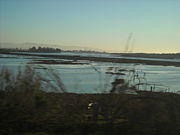Difference between revisions of "Elkhorn Slough National Estuarine Research Reserve (ESNERR)"
(→Research) |
(→Research) |
||
| Line 18: | Line 18: | ||
==Research== | ==Research== | ||
The research and monitoring activities for ESNERR are shaped around national plans that help to establish the priorities, goals and implementation approaches for the program. ESNERR partners with the [[Elkhorn Slough Foundation]] in research, outreach, and training activities. ESNERR designs all research around the defined goals of the National Estuarine Research Reserve system. These goals include promoting open access to the federal and state employees as well as the public. ESNERR conducts research in order better understand the area and aims to address any issues that have been identified by previous research | The research and monitoring activities for ESNERR are shaped around national plans that help to establish the priorities, goals and implementation approaches for the program. ESNERR partners with the [[Elkhorn Slough Foundation]] in research, outreach, and training activities. ESNERR designs all research around the defined goals of the National Estuarine Research Reserve system. These goals include promoting open access to the federal and state employees as well as the public. ESNERR conducts research in order better understand the area and aims to address any issues that have been identified by previous research | ||
| − | + | [[Image:DSCN1503.JPG||thumb|Elkhorn Slough National Estuarine Research Reserve]] | |
The goal of the research program is to better understand estuarine ecosystem as well as their surrounding watersheds. The program has a variety of ongoing research projects that monitor long term trends, but they also have research that focuses on short term threats to the communities and ecosystem. The current research activities at ESNERR are focused on the following topics: | The goal of the research program is to better understand estuarine ecosystem as well as their surrounding watersheds. The program has a variety of ongoing research projects that monitor long term trends, but they also have research that focuses on short term threats to the communities and ecosystem. The current research activities at ESNERR are focused on the following topics: | ||
| − | |||
*1. Eutrophication, effects of non-point source pollution and/or nutrient dynamics; | *1. Eutrophication, effects of non-point source pollution and/or nutrient dynamics; | ||
| Line 27: | Line 26: | ||
*4. Mechanisms for sustaining resources within estuarine ecosystems; or | *4. Mechanisms for sustaining resources within estuarine ecosystems; or | ||
*5. Economic, sociological, and/or anthropological research applicable to estuarine ecosystem management | *5. Economic, sociological, and/or anthropological research applicable to estuarine ecosystem management | ||
| − | |||
| − | |||
== Training Activities== | == Training Activities== | ||
Revision as of 17:27, 2 February 2011
Contents
National Estuarine Research Reserve System (NERRS)
The Elkhorn Slough National Estuarine Research Reserve is a 1,439 acre reserve in the Central Coast of California. ESNERR is one of 27 National Estuarine Research Reserves. NERRS was established by the Coastal Zone Management Act (CZMA) of 1972. CZMA was passed in order to encourage coastal states to "preserve, protect, develop, and where possible, to restore or enhance the resources of the nation's coastal zone[1]." The research reserves includes 28 areas all representing different biological ecosystems. NERRS is in partnership with NOAA, which provides funding and national assistance. Utilizing research and education, the staff actively engage with the community to address important ecosystem issues such as pollution, invasive species and ecological restoration[2].
ESNERR
ESNERR is the largest of thirteen sanctuaries in the National Marine Sanctuary System.[3]. ESNERR is run by the National Oceanic and Atmospheric Administration (NOAA) and managed by the California Department of Fish and Game (CDFG). ESNERR is a coastal embayment, which is an area where freshwater from streams and groundwater mix with surrounding ocean seawater. Elkhorn Slough consists of deepwater subtidal habitats that lay adjacent to intertidal wetlands. Carneros Creek, Pajaro River and old Salinas River supply Elkhorn Slough with a freshwater that meets with pacific ocean at the slough to make a brakish mixture of water within Elkhorn Slough.
Mission
“The mission of the Elkhorn Slough National Estuarine Research Reserve is to improve the understanding and stewardship of Elkhorn Slough and its watershed.”[4] In acieving this mission, the staff and volunteers at Elkhorn Slough and the neighboring watersheds are in the best health. In order to achieve this mission ESNERR has set five conservation targets:
- 1. Tidal estuary
- 2. Coastal prairie/Coastal scrub
- 3. Maritime chaparral
- 4. Riparian/Freshwater wetlands
- 5. Coast live oak woodlands
Research
The research and monitoring activities for ESNERR are shaped around national plans that help to establish the priorities, goals and implementation approaches for the program. ESNERR partners with the Elkhorn Slough Foundation in research, outreach, and training activities. ESNERR designs all research around the defined goals of the National Estuarine Research Reserve system. These goals include promoting open access to the federal and state employees as well as the public. ESNERR conducts research in order better understand the area and aims to address any issues that have been identified by previous research
The goal of the research program is to better understand estuarine ecosystem as well as their surrounding watersheds. The program has a variety of ongoing research projects that monitor long term trends, but they also have research that focuses on short term threats to the communities and ecosystem. The current research activities at ESNERR are focused on the following topics:
- 1. Eutrophication, effects of non-point source pollution and/or nutrient dynamics;
- 2. Habitat conservation and/or restoration;
- 3. Biodiversity and/or the effects of invasive species;
- 4. Mechanisms for sustaining resources within estuarine ecosystems; or
- 5. Economic, sociological, and/or anthropological research applicable to estuarine ecosystem management
Training Activities
A primary goal of ESNERR is “Educate the Community about the Watershed and Inspire Them to Consider Environmental Conservation When Making Decisions Affecting Elkhorn Slough and Its Watershed[4]”. In order to achieve this ESNERR has made a continuous effort to reach out to the community through educational training programs and activities.These outreach programs and workshops cater to a variety of audiences, but the four primary programs are:
- The Coastal Training Program[5]: offers workshops promoting Collaborative Ecosystem Management, workgroups and scientific review to local decision makers. Currently they are offering workshops in:
- School Programs: offers educational field trips and student outreach programs for K-12, college and university courses, and internships for students
- Public Education: Interpretive Hiking Trails and guided tours of the reserve are offered with outreach targeted primarily towards the members of the neighboring community of the Elkhorn Slough watershed
- Volunteer Programs: volunteers are welcome to assist with everything from research and monitoring to implementation of education programs.
ESNERR also offers courses for those who are interested in developing a better understanding the estuarine system.
References
- ↑ NOAA: Coastal Zone Management Act: [http://coastalmanagement.noaa.gov/czm/czm_act.html
- ↑ National Estuarine Research Reserve System: [http://www.nerrs.noaa.gov/BGDefault.aspx?ID=61
- ↑ Elkhorn Slough National Estaurine Research Reserve: [http://www.elkhornslough.org/esnerr/index.ht
- ↑ 4.0 4.1 ESNERR Management Plan 2007-2011:http://www.elkhornslough.org/download/ESNERR_Final_Management_Plan.doc
- ↑ Coastal Outreach Training Program:http://www.elkhornsloughctp.org/ Coastal Outreach Program

